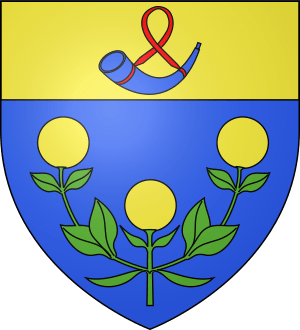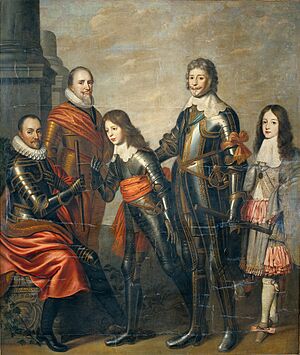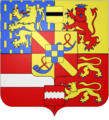Prince of Orange facts for kids

The Prince of Orange is a special title of nobility. It is used by members of the House of Orange-Nassau. They are the heirs to the crown of the Netherlands. Members of the House of Hohenzollern also use this title.
Today, Prince Willem-Alexander of the Netherlands holds the title. He is from the Orange-Nassau family. Georg Friedrich, Prince of Prussia (Hohenzollern) and Guy, Marquis de Mailly-Neslé, Prince d'Orange also use it.
Contents
The Story of the Prince of Orange Title
The title "Prince of Orange" first came from a small, independent state. This state was called the Principality of Orange. It was located in the south of what is now France.
The land belonged to the House of Orange. From 1544, it belonged to the House of Orange-Nassau.
The last prince from the original Orange family was René of Nassau. When he died, he left the principality to his cousin, William the Silent. William was not from the original Orange family. But he was the legal person to inherit the title.
In 1673, during a war, Louis XIV of France took over the lands. He added them to his own kingdom. This happened during a war against William III of Orange. William III was a leader called a stadtholder in the Netherlands.
Louis XIV then gave the principality to Louis of Mailly-Nesles. This person was a very distant relative of the first princes of Orange. His family still claims the title today. In 1714, Louis XIV let Prince Louis Armand of Bourbon-Conti use the land to make money. The principality officially became part of the French Crown in 1731.
William III died without any children who could legally inherit. So, the principality was passed to his closest relative, Frederick I of Prussia. The kings of Prussia used the title "Prince of Orange" until 1918.
John William Friso of Nassau was chosen as the heir to the princes of Orange in the Netherlands. This was according to William III's last wishes. John William Friso was also related to William the Silent through his mother's side of the family.
Many of his descendants became stadtholders. They claimed the principality of Orange based on agnatic inheritance. This means the land was passed down through the male family line. This was similar to how William the Silent inherited from his cousin René. The claim was also based on the wills of Philips William, Maurice, and William III.
Even though they claimed the title, France never let them control the lands of the principality. Because of this history, the later stadtholders of the Netherlands and the current Dutch royal family still hold the title "Prince of Orange."
Princes of Orange Through History
The title of Prince of Orange has been held by different families over many centuries.
Early Princes: House of Baux and Châlon-Arlay
The title first belonged to the House of Baux. Prince Bertrand I became Prince of Orange in 1173. The Holy Roman Emperor Frederick I made the County of Orange a principality for him.
Later, the title passed to the House of Baux-Orange. These princes ruled the principality for many years. After them, the House of Châlon-Arlay took over. Prince John I was the first from this family to hold the title in 1393.
The House of Nassau and Orange-Nassau
The title then came to the House of Nassau. Prince René became Prince of Orange in 1530. He was an important figure.
After René, the title went to the House of Orange-Nassau. This is the family that is still connected to the title today.
- Prince William I became Prince of Orange in 1544. He was a very famous leader in Dutch history.
- His son, Prince Philip William, inherited the title in 1584.
- Then came Prince Maurice in 1618.
- Prince Frederick Henry became Prince in 1625.
- Prince William II followed in 1647.
- Finally, William III became Prince in 1650. He later became King of England, Scotland, and Ireland.
The Title Today: Orange-Nassau, Hohenzollern, and Mailly
After William III, the title became a personal title of nobility. It was no longer tied to the land of the principality.
The House of Orange-Nassau continued to use the title.
- Prince John William Friso became Prince in 1702.
- Prince William IV followed in 1711.
- Prince William V became Prince in 1751.
- His son, Prince William VI, later became William I, the first King of the Netherlands in 1815. At this point, the title became a royal title for the heir to the Dutch throne.
Since then, the title "Prince of Orange" has been given to the person who is next in line to become King or Queen of the Netherlands.
- William II was the first Prince of Orange as heir to the Dutch Crown in 1815.
- William III became Prince of Orange in 1840.
- Prince William (son of William III) held the title from 1849.
- Prince Alexander (another son of William III) held it from 1879.
- Today, Prince Willem-Alexander holds the title. He became Prince of Orange in 1980 when his mother became Queen.
Other families also claim the title:
- The House of Hohenzollern: Frederick I of Prussia claimed the title in 1702. His descendants, like Georg Friedrich, Prince of Prussia, still use it.
- The House of Mailly: Louis de Mailly was given the title by the French king. His family, including Guy, Marquis de Nesle and of Mailly, still claims it.
- The House of Bourbon: Louis Armand de Bourbon was also appointed by the French king to use the title.
Related pages
Images for kids
-
An alternate coat of arms sometimes used by Princes of Orange.
See also
 In Spanish: Príncipe de Orange para niños
In Spanish: Príncipe de Orange para niños





